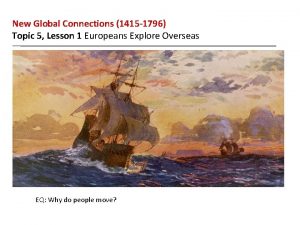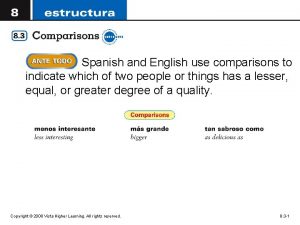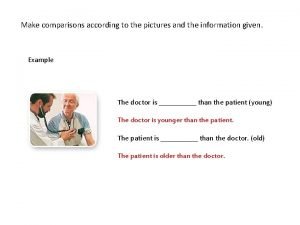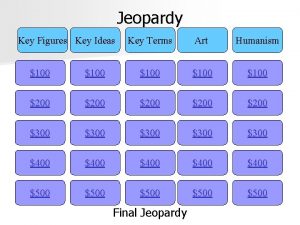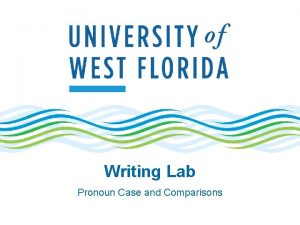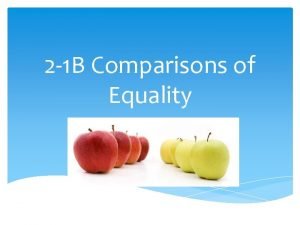Theory Key Terms Key ideas summary Connections Comparisons














- Slides: 14

Theory Key Terms Key ideas (summary) Connections / Comparisons? Evaluation?

Theory Key Terms Key ideas (summary) Connections / Comparisons? Evaluation?

Social Class and Crime Critically examine how and why there are class differences in the distribution of offenders

Social Class – The ‘Facts’ • A variety of data show a link between social class and known offending. • For example, 41 per cent of prisoners are from social classes IV and V (19% of the general population) against only 18 per cent of prisoners from social classes I, II or III (45% of the general population) (Walmsley et al. , 1994). • A study of persistent young offenders also found that only 8% were from households whose head was in non-manual employment (Hagell and Newburn, 1994). • Generally, though, studies of self-reported offending show less difference in offending between social classes (Riley and Shaw, 1985; Graham and Bowling, 1995).

Class group Examples of jobs Middle/ working class I Professional occupations Accountant, doctor, university lecturer MC II Managerial and technical Teacher, nurse, librarian, manager MC III-N Skilled occupations – non-manual Sales rep, shop assistant, secretary MC III-M Skilled occupations Electrician, plumber, joiner – manual category WC IV Partly skilled occupations Postal worker, farm worker, bar worker WC V Unskilled occupations Cleaner, refuse collector, porter WC

Marxists and others argue that social class is the significant factor Middle class parents can be poor parents too but because of cultural capital kids can avoid the pitfalls of juvenile delinquency It’s not all the lower Working Class – Marxists and others argue that the concentration on lower class crime ignores the big area of white collar crime


How does this relate to what we know? • Stanley Cohen - Folk devils and moral panics • Albert Cohen - Status Frustration • Sub-cultural theories? - illegitimate opportunity structure (Cloward & Ohlin), - drift into subterranean values (Matza), - ‘underclass’ (Murrey) • Locality factors? - mobility - Shaw & Mc. Kay - Policing policies / labels

Key facts Ø Young, working class are more likely to commit criminal acts than older, middle class. Ø A typical prisoner in the U. K will be under 30 and working class. Labelling theory – age and class Young working class people especially boys are more likely to be stopped and searched and labelled as criminals by the police and courts. Functionalism –Functionalists like Merton say young working class people commit crime because they strive for success but lack the necessary educational skills and qualifications. They want the goal of success but must achieve it illegitimately. (Innovation) Subcultural theory Young working class people join gangs because they are frustrated at their status in mainstream society. They solve this by rejecting mainstream norms and values, joining a gang and achieving a status through non-utilitarian crimes. Class and crime Left realism – Age and class Most crime is committed by working class people against working class people. Perhaps because relative deprivation, individualism and that fact we live in a bulimic society (the idea that we are exposed to consumer products but cannot consume them). Right realism – class Right realists like Charles Murray believe that single parent families fail to socialise their children effectively due to a lack of male role models, they also grow up to be welfare dependant.

Marxism The working class are no more criminals than anyone else, however the law protects the bourgeoisie so the working class become easier to criminalise. The working class get harsher punishments compared with those who commit white collar crimes. Corporate crime Very difficult to prosecute due to problems of who is responsible and who is a victim. Much Corporate crime is not dealt with criminally but administratively by external agencies like the EPA (Environmental Protection Agency) and the Trading Standards Agency. Only serious cases go to court. Blue collar crime Crimes committed by manual factory workers (working class), these are street crimes like theft which are in public view. Class Social classand crime White collar crime Crimes committed by office workers (middle/upper class) like fraud, these are often hidden from public view. Case study – Guinness affair False claims of success led to high share prices and company directors making millions. Gerald Ronson received a one -year sentence in Ford (open prison) and was released on parole after serving about 6 months. He is still a successful businessman and one of Britain's 100 richest people.

Key Words • White Collar Crime: A crime committed by a person of high social status against a company or a person. • Corporate Crime: Crime committed by a company. • Blue Collar crime: Crime committed by the working class.

Merton • Merton (functionalism) believes that working class, young males are more likely to be criminal because of educational failure. • Which group would Merton argue that they fit into? Why?

Environmental (locality) Theories • They tend to look at why working class areas have higher rates of crime than middle class areas. • They focus on arguments such as the ‘Zones of Transition’ and differential association. • Owen Gill suggested that police labeling and deviancy amplification may push up crime in certain areas.

Social Action Theory • They believe that the young working class (boys) are negatively labelled by the police and the courts. They are seen as criminal. • This is illustrated by Chambliss and his work on the Saints and the Roughnecks.
 Key terms in postcolonial theory
Key terms in postcolonial theory Postcolonial literature
Postcolonial literature Polynomial degrees and terms
Polynomial degrees and terms What are like terms
What are like terms New global connections unit test
New global connections unit test Bc science connections 8 download
Bc science connections 8 download Career connections answer key
Career connections answer key Compiler design mcq
Compiler design mcq Compiler bridges the semantic gap between which domains?
Compiler bridges the semantic gap between which domains? Ideas have consequences bad ideas have victims
Ideas have consequences bad ideas have victims Ideas secundarias
Ideas secundarias Tú eres 1 of 1 (less) simpático que federico.
Tú eres 1 of 1 (less) simpático que federico. Example of simile sentence
Example of simile sentence Making comparisons
Making comparisons According to the pictures
According to the pictures




